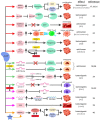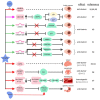The Role of RNA Editing in Cancer Development and Metabolic Disorders
- PMID: 30619092
- PMCID: PMC6305585
- DOI: 10.3389/fendo.2018.00762
The Role of RNA Editing in Cancer Development and Metabolic Disorders
Abstract
Numerous human diseases arise from alterations of genetic information, most notably DNA mutations. Thought to be merely the intermediate between DNA and protein, changes in RNA sequence were an afterthought until the discovery of RNA editing 30 years ago. RNA editing alters RNA sequence without altering the sequence or integrity of genomic DNA. The most common RNA editing events are A-to-I changes mediated by adenosine deaminase acting on RNA (ADAR), and C-to-U editing mediated by apolipoprotein B mRNA editing enzyme, catalytic polypeptide 1 (APOBEC1). Both A-to-I and C-to-U editing were first identified in the context of embryonic development and physiological homeostasis. The role of RNA editing in human disease has only recently started to be understood. In this review, the impact of RNA editing on the development of cancer and metabolic disorders will be examined. Distinctive functions of each RNA editase that regulate either A-to-I or C-to-U editing will be highlighted in addition to pointing out important regulatory mechanisms governing these processes. The potential of developing novel therapeutic approaches through intervention of RNA editing will be explored. As the role of RNA editing in human disease is elucidated, the clinical utility of RNA editing targeted therapies will be needed. This review aims to serve as a bridge of information between past findings and future directions of RNA editing in the context of cancer and metabolic disease.
Keywords: ADAR; APOBEC1; RNA editing; cancer; metabolic disease.
Figures







Similar articles
-
RNA editing of BFP, a point mutant of GFP, using artificial APOBEC1 deaminase to restore the genetic code.Sci Rep. 2020 Oct 14;10(1):17304. doi: 10.1038/s41598-020-74374-5. Sci Rep. 2020. Retraction in: Sci Rep. 2025 Feb 11;15(1):5060. doi: 10.1038/s41598-025-89490-3. PMID: 33057101 Free PMC article. Retracted.
-
RNA binding to APOBEC deaminases; Not simply a substrate for C to U editing.RNA Biol. 2017 Sep 2;14(9):1153-1165. doi: 10.1080/15476286.2016.1259783. Epub 2016 Nov 21. RNA Biol. 2017. PMID: 27869537 Free PMC article. Review.
-
Flow-cytometric visualization of C>U mRNA editing reveals the dynamics of the process in live cells.RNA Biol. 2015;12(4):389-97. doi: 10.1080/15476286.2015.1026033. RNA Biol. 2015. PMID: 25806564 Free PMC article.
-
Epitranscriptomic profiling across cell types reveals associations between APOBEC1-mediated RNA editing, gene expression outcomes, and cellular function.Proc Natl Acad Sci U S A. 2017 Dec 12;114(50):13296-13301. doi: 10.1073/pnas.1714227114. Epub 2017 Nov 22. Proc Natl Acad Sci U S A. 2017. PMID: 29167373 Free PMC article.
-
RNA rewriting, recoding, and rewiring in human disease.Trends Mol Med. 2015 Sep;21(9):549-59. doi: 10.1016/j.molmed.2015.07.001. Epub 2015 Aug 7. Trends Mol Med. 2015. PMID: 26259769 Review.
Cited by
-
A-to-I RNA Editing in Cancer: From Evaluating the Editing Level to Exploring the Editing Effects.Front Oncol. 2021 Feb 11;10:632187. doi: 10.3389/fonc.2020.632187. eCollection 2020. Front Oncol. 2021. PMID: 33643923 Free PMC article. Review.
-
A-to-I nonsynonymous RNA editing was significantly enriched in the ubiquitination site and correlated with clinical features and immune response.Sci Rep. 2022 Sep 5;12(1):15079. doi: 10.1038/s41598-022-18926-x. Sci Rep. 2022. PMID: 36064557 Free PMC article.
-
Genome-wide detection of RNA editing events during the hair follicles cycle of Tianzhu white yak.BMC Genomics. 2022 Oct 31;23(1):737. doi: 10.1186/s12864-022-08951-5. BMC Genomics. 2022. PMID: 36316632 Free PMC article.
-
ADAR expression and copy number variation in patients with advanced gastric cancer.BMC Gastroenterol. 2020 May 14;20(1):152. doi: 10.1186/s12876-020-01299-8. BMC Gastroenterol. 2020. PMID: 32410589 Free PMC article.
-
N6-methyladenosine promotes induction of ADAR1-mediated A-to-I RNA editing to suppress aberrant antiviral innate immune responses.PLoS Biol. 2021 Jul 29;19(7):e3001292. doi: 10.1371/journal.pbio.3001292. eCollection 2021 Jul. PLoS Biol. 2021. PMID: 34324489 Free PMC article.
References
Publication types
Grants and funding
LinkOut - more resources
Full Text Sources
Other Literature Sources
Research Materials
Miscellaneous

